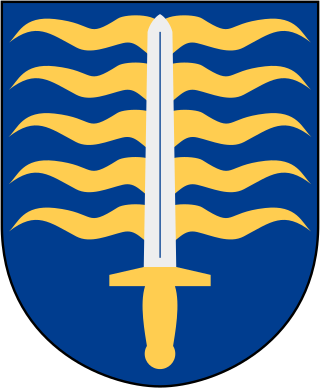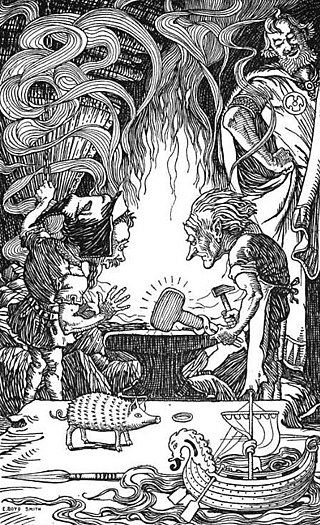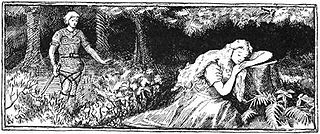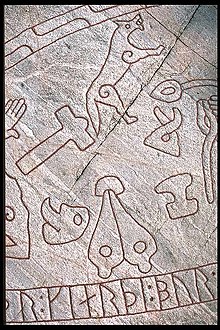
Loki is a god in Norse mythology. He is the son of Fárbauti and Laufey, and the brother of Helblindi and Býleistr. Loki is married to the goddess Sigyn and they have two sons, Narfi or Nari and Váli. By the jötunn Angrboða, Loki is the father of Hel, the wolf Fenrir and the world serpent Jörmungandr. In the form of a mare, Loki was impregnated by the stallion Svaðilfari and gave birth to the eight-legged horse Sleipnir.

Weregild, also known as man price, was a precept in some historical legal codes whereby a monetary value was established for a person's life, to be paid as a fine or as compensatory damages to the person's family if that person was killed or injured by another.

A dwarf is a type of supernatural being in Germanic folklore. Accounts of dwarfs vary significantly throughout history; however, they are commonly, but not exclusively, presented as living in mountains or stones and being skilled craftsmen. In early literary sources, only males are explicitly referred to as dwarfs. However, they are described as having sisters and daughters, while male and female dwarfs feature in later saga literature and folklore. Dwarfs are sometimes described as short; however, scholars have noted that this is neither explicit nor relevant to their roles in the earliest sources.

The Völsunga saga is a legendary saga, a late 13th-century prose rendition in Old Norse of the origin and decline of the Völsung clan. It is one of the most famous legendary sagas and an example of a "heroic saga" that deals with Germanic heroic legend.

In Norse mythology, Reginn is a son of Hreiðmarr and the foster father of Sigurð. His brothers are Fáfnir and Ótr.
In Norse mythology, Hreiðmarr is a sorcerer. He is featured in the Völsunga saga and in Snorri Sturluson's Prose Edda.

In Germanic heroic legend and folklore, Fáfnir is a worm or dragon slain by a member of the Völsung family, typically Sigurð. In Nordic mythology, he is the son of Hreiðmarr, and brother of Regin and Ótr and is attested throughout the Völsung Cycle, where, Fáfnir slays his father out of greed, taking the ring and hoard of the dwarf Andvari and becoming a worm or dragon. Fáfnir's brother Regin later assisted Sigurð in obtaining the sword Gram, by which Fáfnir is killed. He has been identified with an unnamed dragon killed by a Völsung in other Germanic works including Beowulf, the Nibelunglied and a number of skaldic poems. Fáfnir and his killing by Sigurð are further represented in numerous medieval carvings from the British Isles and Scandinavia, and a single axe head in a Scandinavian style found in Russia. The story of Fáfnir has continued to have influence in the modern period, such as in the works of J.R.R Tolkien, who drew inspiration from the tale of Fáfnir in his portrayals of Smaug and Gollum.

In Norse mythology, Andvaranaut, meaning Andvari's Gem, is a magic ring, initially owned by Andvari, that could help with finding sources of gold.

Tyrfing, also rendered as Tirfing or Tyrving, was a magic sword in Norse mythology, which features in the Tyrfing Cycle, which includes a poem from the Poetic Edda called Hervararkviða, and the Hervarar saga. The name is also used in the saga to denote the Goths.

In Norse mythology, Andvari is a dwarf who lives underneath a waterfall and has the power to change himself into a pike (gedda) at will.

In Norse mythology, the Sons of Ivaldi are a group of dwarfs who fashion Skíðblaðnir, the flying ship of Freyr, Gungnir, the spear belonging to Odin, as well as the golden hair for Sif to replace the hair that Loki had cut off.

The term Nibelung (German) or Niflungr is a personal or clan name with several competing and contradictory uses in Germanic heroic legend. It has an unclear etymology, but is often connected to the root Nebel, meaning mist. The term in its various meanings gives its name to the Middle High German heroic epic the Nibelungenlied.

Worms, wurms or wyrms, meaning serpent, are archaic terms for dragons in the wider Germanic mythology and folklore, in which they are often portrayed as large venomous snakes and hoarders of gold. Especially in later tales, however, they share many common features with other dragons in European mythology, such as having wings.
The Norse mythology, preserved ancient Icelandic texts such as the Poetic Edda, the Prose Edda, and other lays and sagas, was little known outside Scandinavia until the 19th century. With the widespread publication of Norse myths and legends at this time, references to the Norse gods and heroes spread into European literary culture, especially in Scandinavia, Germany, and Britain. In the later 20th century, references to Norse mythology became common in science fiction and fantasy literature, role-playing games, and eventually other cultural products such as Japanese animation. Storytelling was an important aspect of Norse mythology and centuries later, with the rediscovery of the myth, Norse mythology once again relies on the impacts of storytelling to spread its agenda.

The Salmon of Knowledge is a creature in the Fenian Cycle of Irish mythology, sometimes identified with Fintan mac Bóchra, who was known as "The Wise" and was once transformed into a salmon.

The Sigurd stones form a group of eight or nine Swedish runic inscriptions and one picture stone that depict imagery from the Germanic heroic legend of Sigurd the dragon slayer. They were made during the Viking Age and constitute the earliest Norse representations of the matter of the Völsung cycle that is the basis of the Middle High German Nibelungenlied and the Sigurd legends in the Poetic Edda, the Prose Edda, and the Völsunga saga.

Sigurd or Siegfried is a legendary hero of Germanic heroic legend, who killed a dragon—known in some Old Norse sources as Fáfnir—and who was later murdered, in the Nordic countries with the epithet "Fáfnir's bane", but widely also "the Dragon Slayer". In both the Norse and continental Germanic tradition, Sigurd is portrayed as dying as the result of a quarrel between his wife (Gudrun/Kriemhild) and another woman, Brunhild, whom he has tricked into marrying the Burgundian king Gunnar/Gunther. His slaying of a dragon and possession of the hoard of the Nibelungen is also common to both traditions. In other respects, however, the two traditions appear to diverge. The most important works to feature Sigurd are the Nibelungenlied, the Völsunga saga, and the Poetic Edda. He also appears in numerous other works from both Germany and Scandinavia, including a series of medieval and early modern Scandinavian ballads.

The Legend of Sigurd and Gudrún is a book containing two narrative poems and related texts composed by English writer J. R. R. Tolkien. It was published by Houghton Mifflin Harcourt and HarperCollins on 5 May 2009.

Skáldskaparmál is the second part of the Prose Edda, compiled by Snorri Sturluson. It consists of a dialogue between Ægir, the divine personification of the sea, and Bragi, the god of poetry, in which both stories of the Æsir and discourse on the nature of poetry are intertwined. The work additionally includes tales of human heroes and kings. The overarching mythological setup gradually fades and the work becomes more of an early form of a poetic thesaurus of Old Norse, presumably intended for usage by skalds. Much of the work is focused on poetic phrases and descriptors. The origin of these kennings is given; Bragi delivers a systematic list of kennings for various Æsir, people, places, and things. He then goes on to discuss poetic language in some detail, in particular heiti, essentially poetic synonyms or alternate words. For example, the simple hestr, "horse", might be replaced by jór, "steed".

A prominent position is held by rings in early Germanic cultures, appearing both in archaeology throughout areas settled by Germanic peoples, and in textual sources discussing their practices and beliefs. They are notably associated with the related aspects of wealth, being used as forms of currency in the Early Medieval Period, and swearing sacred oaths, often dedicated to, or witnessed by, the gods. The sacrality of rings is reflected in Germanic mythology and ring bestowal held a central role in maintaining functional relationships between rulers and their retinues. The cultural roles of rings continued to varying extents during and after the Christianisation of the Germanic peoples, such as in gift-bestowal and oath-swearing.



















